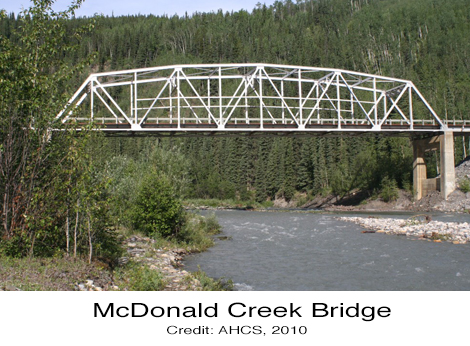McDonald Creek Bridge
The McDonald Creek Bridge, built in 1943, is located along a spectacular section of the Alaska Highway that winds over waterways and around densely forested mountains in British Columbia. Located at kilometer 628, the bridge is a good example of a design often used by the US Public Roads Administration (PRA).
Under great time pressure to create this wartime supply route, the US PRA design team focused on providing adaptable designs that could solve standard crossings along the route. One of these standard designs was the steel Polygonal Warren through truss bridge, based on a design patented in Britain in 1848. The US PRA adopted the Polygonal Warren through truss as a standardized truss because it offered not only a pleasing appearance, but also economical use of materials. Standardized designs meant components could be pre-fabricated and adapted to most sites, which reduced the cost of production and the need for specialized training and equipment to build the bridges. This often-used bridge design soon became an easily recognizable and distinct engineering work on the Alaska Highway.
The three-span McDonald Creek Bridge, 94.49 m (310 feet) long, is one of the three bridges of its type still standing on the Canadian section of the Alaska Highway. Its name honours Charlie McDonald, from the Cree First Nation, who was one of the many local Indigenous guides who helped survey and mark the best route during the highway’s construction.

